Sales of plant-based ready meals in the United States are estimated at USD 0.75 billion in 2025, with projections indicating a rise to USD 1.85 billion by 2035, reflecting a CAGR of approximately 9% over the forecast period.
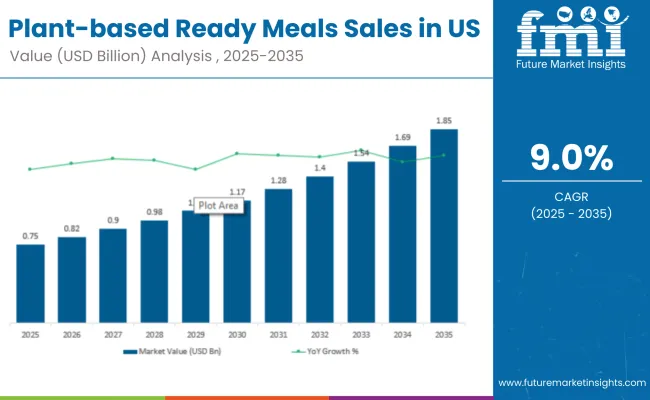
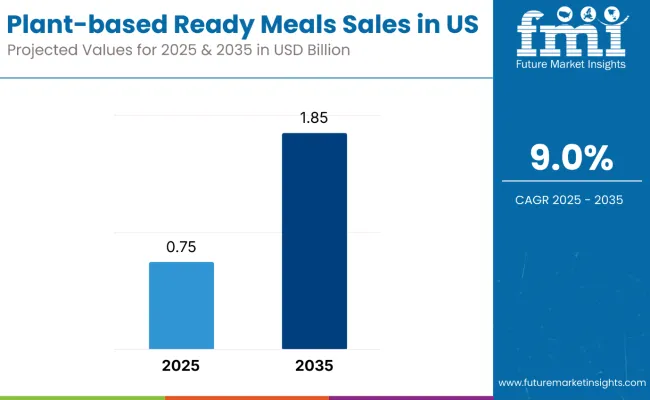
This growth reflects both a broadening consumer base and increased per capita consumption in key urban centres. The rise in demand is linked to shifting dietary preferences, growing awareness of sustainability, and evolving convenience trends.
By 2025, per capita consumption in leading US states such as California, Texas, and Florida averages between 1.3 to 1.5 kilograms, with projections reaching 1.9 kilograms by 2035. New York City leads among metropolitan areas, expected to generate USD 285 million in plant-based ready-meal sales by 2035, followed by Los Angeles (USD 129 million), Chicago (USD 87 million), Houston (USD 73 million), and Phoenix (USD 52 million).
The largest contribution to demand continues to come from frozen plant-based entrées, which are expected to account for 68% of total sales in 2025, owing to strong shelf presence, extended storage life, and retailer support. By distribution channel, supermarkets represent the dominant retail format, responsible for 54% of all sales, while mass merchandisers and online grocery platforms are expanding rapidly.
Consumer adoption is particularly concentrated among young urban families and eco-conscious millennials, with income and urban density emerging as significant drivers of demand. While price remains a limiting factor, the average price premium over conventional meat-based ready meals has declined from 21% in 2020 to 13% in 2025.
Continued improvements in manufacturing scale and private label offerings are expected to accelerate affordability and access across mid-income households. Regional disparities persist, but per capita demand in high-growth Sun Belt cities is narrowing the gap with traditionally strong coastal urban hubs.
The plant-based ready meals segment in the US is classified across several segments. By product, the key categories include frozen entrées, chilled microwaveable meals, shelf-stable bowls and pouches, and meal kits with plant protein. By distribution channel, the segment spans supermarkets, mass merchandisers, online grocery and direct-to-consumer platforms, convenience stores, and natural food co-ops.
By protein source, formulations include soy protein, pea protein, wheat/seitan, lentils and pulses, and blended or emerging sources such as chickpea, fava bean, and myco-protein. By consumer profile, the segment covers young urban families, eco-motivated millennials, flexitarian boomers, Gen-Z snackers, and individuals with dietary or lifestyle restrictions.
By region, states such as California, Texas, Florida, New York, and Pennsylvania are included, along with coverage across all 50 states and Washington, D.C. By city, key metro areas analyzed include New York, Los Angeles, Chicago, Houston, and Phoenix.
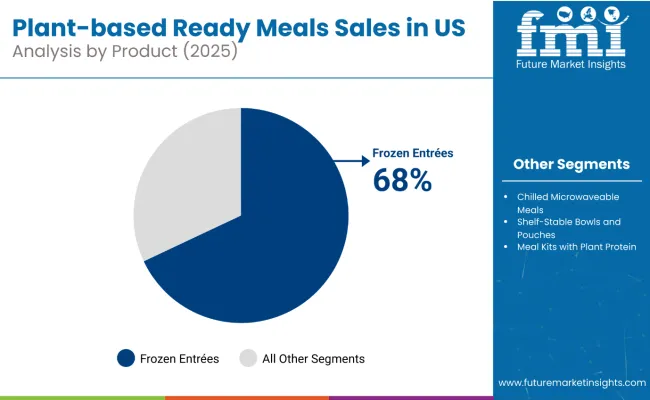
Frozen entrées are projected to dominate sales in 2025, supported by freezer-aisle visibility, long shelf life, and category familiarity. Other formats such as chilled, shelf-stable, and meal kits are growing steadily, each serving distinct consumption needs.
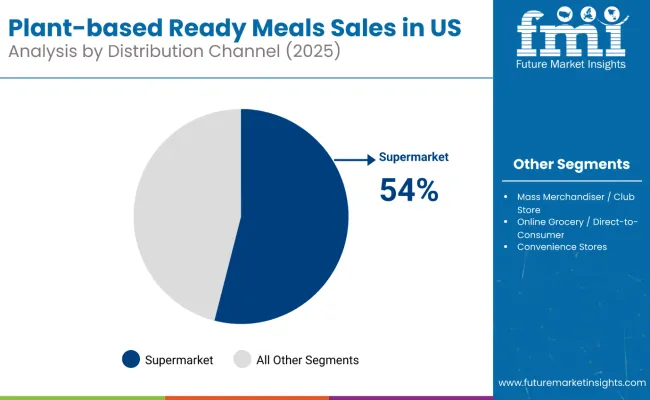
Plant-based ready meals in the USA are distributed through a mix of mainstream retail and alternative sales channels. Supermarkets are expected to remain the primary point of sale in 2025, followed by mass merchandisers and online grocery. Distribution strategies are evolving to match consumer shopping behavior, with growth coming from both physical and digital formats.
Plant-based ready meals in the USA utilize a variety of protein bases, selected for cost, texture, allergen profile, and nutritional content. Soy remains the most widely used protein input, though alternatives like pea and lentil proteins are gaining momentum. Product developers are increasingly exploring hybrid and novel proteins to meet evolving dietary and regulatory demands.
The plant-based ready meals category appeals to a diverse consumer base across age groups, income levels, and dietary preferences. While motivations vary from health to ethics to convenience, demand is concentrated among five key demographic clusters. Each group brings distinct purchase behaviors, channel preferences, and product expectations.
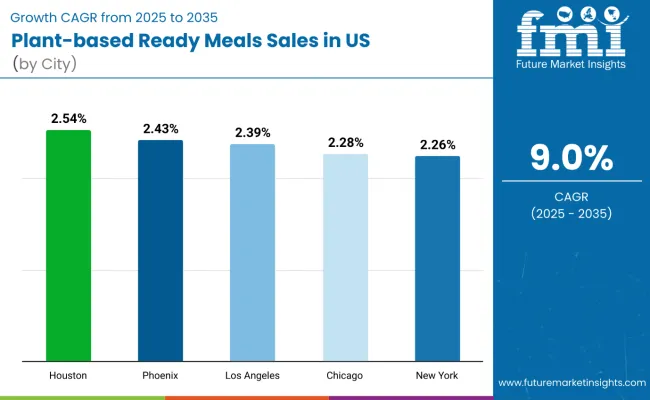
Plant-based ready-meal sales will not grow uniformly across every metro area. Rising population inflows and faster per-capita adoption in the Sun-Belt give Houston and Phoenix a measurable edge, while mature coastal hubs such as New York expand more steadily from a higher base. The table below shows the compound annual growth rate (CAGR) each of the five largest cities is expected to record between 2025 and 2035.
Among the top five cities analyzed, Houston and Phoenix are expected to register the fastest compound annual growth rate (CAGR) of 2.54%, outpacing more mature coastal hubs. This acceleration is underpinned by a combination of factors: strong net migration, growing suburban populations, and increasing availability of plant-based formats across mass retailers and club stores.
In both cities, per capita consumption is projected to rise from 1.4 kg in 2025 to 1.8 kg by 2035, closing the gap with higher-consumption cities such as New York and Los Angeles. Retail assortment is also expanding faster in these regions, with new shelf-stable and chilled formats gaining traction in neighborhoodgrocers and convenience chains.
Los Angeles and Chicago are each forecast to grow at a CAGR of 2.39% over the same period. Both cities already maintain established retail ecosystems, with widespread access to frozen and chilled plant-based ready meals in supermarkets, specialty stores, and ethnic retailers.
In Los Angeles, growth is supported by a strong health-conscious consumer base, brand experimentation, and increasing uptake of private label offerings. Chicago reflects similar dynamics, particularly among flexitarian consumers and households seeking portion-controlled, microwaveable meals. In both cities, per capita consumption is projected to increase from 1.5 kg in 2025 to 1.9 kg by 2035, reflecting mainstreaming of plant-based convenience options.
New York City, while maintaining the highest overall sales in absolute terms, is expected to grow at a CAGR of 2.26%, slightly below its Sun Belt counterparts. The city already exhibits higher-than-average per capita intake (1.6 kg in 2025), extensive product saturation, and a dense urban retail network. Growth will likely come from repeat purchasing, new chilled formats, and ethnic product expansion rather than first-time trial.
Collectively, these five metro areas represent the core of urban demand for plant-based ready meals in the USA, but their individual growth paths highlight the importance of regional tailoring in pricing, format development, and channel strategy.
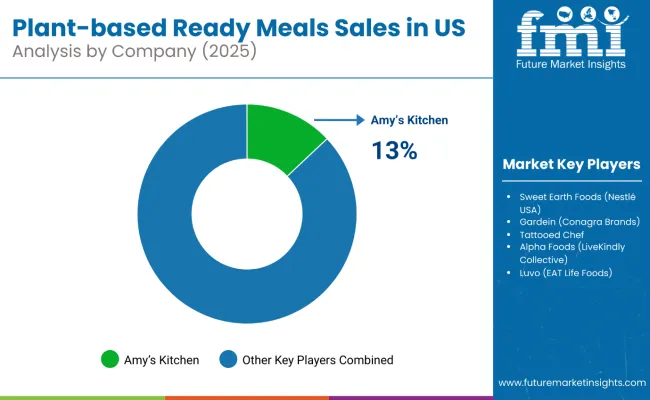
The competitive environment is characterised by a mix of long-established convenience-food manufacturers and newer, plant-exclusive entrants. Distribution breadth rather than sheer product count remains the decisive success factor: the five largest suppliers collectively reach more than 30,000 retail outlets nationwide and account for a majority of frozen and chilled shelf facings in the category.
Amy’s Kitchen is the most mature participant. Still privately held, the company offers more than 250 vegetarian SKUs, all certified organic or non-GMO. Its core range of frozen entrées and bowls gives it deep penetration in natural-channel supermarkets while maintaining full national coverage through Kroger, Walmart and Target.
Sweet Earth Foods, acquired by Nestlé USA in 2017, leverages Nestlé’s deep-frozen distribution network to place plant-based burritos, bowls and pizza alternatives in mainstream supermarkets and club stores. Post-integration gains in logistics efficiency have allowed Sweet Earth to introduce multi-serve tray meals priced near parity with conventional frozen entrées, reinforcing its role as Nestlé’s primary vehicle for USA plant-based expansion.
Gardein, owned by Conagra Brands, benefits from scale synergies inside a USD 12 billion frozen-foods portfolio and from co-manufacturing with other Conagra lines. Recent launches under the Ultimate Plant-Based sub-brand extend Gardein beyond meat analogues into meal-ready skillet bowls and stir-fry kits formats expressly targeting the ready-meal shopper.
The next tier comprises specialist or recently public companies. Tattooed Chef focuses on vegetable-forward frozen bowls and handheld meals; Q3-2022 Securities and Exchange Commission filings showed quarterly sales of USD 54 million, signalling national but still niche scale. Alpha Foods, now part of LiveKindly Collective after a 2023 acquisition, adds plant-based burritos and tamale-style entrées to LiveKindly’s USA footprint and is expected to benefit from cross-brand procurement and promotional budgets.
Private-label programmes at Whole Foods (365), Kroger (Simple Truth) and Target (Good & Gather) are widening assortment at price points 10-15% below branded equivalents, putting margin pressure on smaller suppliers while supporting household entry. Consolidation is therefore likely to continue as manufacturing scale and omnichannel reach become critical for maintaining shelf visibility and promotional frequency in this fast-evolving category.
Key Developments
| Attribute | Details |
|---|---|
| Study Coverage | USA sales and consumption of plant-based ready meals from 2020 to 2035 |
| Base Year | 2025 |
| Historical Data | 2020 |
| Forecast Period | 2025 to 2035 |
| Units of Measurement | USD (sales), Metric Tonnes (volume), Kilograms per capita (consumption) |
| Geography Covered | All 50 USA states + Washington D.C., state-level and city-level granularity |
| Top States Analyzed | California, Texas, Florida, New York, Pennsylvania,50 |
| Top Cities Analyzed | New York, Los Angeles, Chicago, Houston, Phoenix and 50+ |
| By Product Format | Frozen entrées, Chilled microwaveable meals, Shelf-stable bowls/pouches, Meal kits |
| By Distribution Channel | Supermarkets, Mass merchandisers/club stores, Online grocery/DTC, Convenience stores, Co-ops |
| By Protein Source | Soy, Pea, Wheat (seitan), Lentils/pulses, Chickpea/fava blends, Mycoprotein, Algae-based |
| By Consumer Profile | Young urban families, Eco-motivated millennials, Flexitarian boomers, Gen-Z snackers, Lifestyle-restricted consumers |
| Metrics Provided | Sales (USD), Volume (MT), Per capita consumption (kg), CAGR (2025 to 2035), Share by segment |
| Price Analysis | Average unit prices by product format and region |
| Competitive Landscape | Company profiles, private label strategies, entry-level brand presence, national vs. regional |
| Forecast Drivers | Per capita demand trends, channel expansion, price convergence, population growth |
By 2035, total USA sales of plant-based ready meals are projected to reach USD 1.85 billion, up from USD 0.75 billion in 2025, reflecting a CAGR of approximately 9%.
Frozen entrées hold the leading share, accounting for approximately 68% of total sales in 2025, followed by chilled microwaveable meals and shelf-stable bowls.
Houston and Phoenix lead in projected growth, each registering a CAGR of 2.54% between 2025 and 2035, due to population growth and widening distribution.
Supermarkets are the dominant sales channel (54% share in 2025), but online grocery and direct-to-consumer platforms are growing at double-digit CAGR, especially in urban regions.
Major players include Amy’s Kitchen, Sweet Earth (Nestlé), Gardein (Conagra), Tattooed Chef, and Alpha Foods, with growing competition from private label brands like Kroger’s Simple Truth and Target’s Good & Gather.






Our Research Products

The "Full Research Suite" delivers actionable market intel, deep dives on markets or technologies, so clients act faster, cut risk, and unlock growth.

The Leaderboard benchmarks and ranks top vendors, classifying them as Established Leaders, Leading Challengers, or Disruptors & Challengers.

Locates where complements amplify value and substitutes erode it, forecasting net impact by horizon

We deliver granular, decision-grade intel: market sizing, 5-year forecasts, pricing, adoption, usage, revenue, and operational KPIs—plus competitor tracking, regulation, and value chains—across 60 countries broadly.

Spot the shifts before they hit your P&L. We track inflection points, adoption curves, pricing moves, and ecosystem plays to show where demand is heading, why it is changing, and what to do next across high-growth markets and disruptive tech

Real-time reads of user behavior. We track shifting priorities, perceptions of today’s and next-gen services, and provider experience, then pace how fast tech moves from trial to adoption, blending buyer, consumer, and channel inputs with social signals (#WhySwitch, #UX).

Partner with our analyst team to build a custom report designed around your business priorities. From analysing market trends to assessing competitors or crafting bespoke datasets, we tailor insights to your needs.
Supplier Intelligence
Discovery & Profiling
Capacity & Footprint
Performance & Risk
Compliance & Governance
Commercial Readiness
Who Supplies Whom
Scorecards & Shortlists
Playbooks & Docs
Category Intelligence
Definition & Scope
Demand & Use Cases
Cost Drivers
Market Structure
Supply Chain Map
Trade & Policy
Operating Norms
Deliverables
Buyer Intelligence
Account Basics
Spend & Scope
Procurement Model
Vendor Requirements
Terms & Policies
Entry Strategy
Pain Points & Triggers
Outputs
Pricing Analysis
Benchmarks
Trends
Should-Cost
Indexation
Landed Cost
Commercial Terms
Deliverables
Brand Analysis
Positioning & Value Prop
Share & Presence
Customer Evidence
Go-to-Market
Digital & Reputation
Compliance & Trust
KPIs & Gaps
Outputs
Full Research Suite comprises of:
Market outlook & trends analysis
Interviews & case studies
Strategic recommendations
Vendor profiles & capabilities analysis
5-year forecasts
8 regions and 60+ country-level data splits
Market segment data splits
12 months of continuous data updates
DELIVERED AS:
PDF EXCEL ONLINE
USA Frozen Ready Meals Market Analysis – Growth, Applications & Outlook 2025-2035
Australia Frozen Ready Meals Market Insights – Demand, Size & Industry Trends 2025–2035
Ready Meals Packaging Market Size and Share Forecast Outlook 2025 to 2035
Competitive Overview of Ready Meals Packaging Market Share
Ready to Use Intermittent Catheters Market Size and Share Forecast Outlook 2025 to 2035
Ready-to-Use Therapeutic Food Market Trends and Forecast 2025 to 2035
Sales of Used Bikes through Bike Marketplaces Market- Growth & Demand 2025 to 2035
Ready-To-Use Supplementary Food Market Analysis Hospital & Clinics, Charities, NGOs, And Others Through 2035
Used Passenger Car Sales Market
Frozen Ready Meals Market Analysis - Size, Share, and Forecast Outlook 2025 to 2035
United Kingdom Frozen Ready Meals Market Analysis – Growth, Trends & Forecast 2025–2035
Sales Analysis of Tourism Industry in the Middle East Size and Share Forecast Outlook 2025 to 2035
Retail Sales of Kvass in Russia and CIS countries Analysis - Size, Share & Forecast 2025 to 2035
Frozen Cooked Ready Meals Market Report – Demand, Trends & Industry Forecast 2025-2035
Latin America Frozen Ready Meals Market Insights – Demand & Forecast 2025–2035
US Convenience Confectionery Retail Sales Analysis - Size, Share & Forecast 2025 to 2035
Sales Platforms Software Market Size and Share Forecast Outlook 2025 to 2035
Ready-to-eat Canned Tuna Market Size and Share Forecast Outlook 2025 to 2035
Salesforce Services Market Size and Share Forecast Outlook 2025 to 2035
USB Type C Market Size and Share Forecast Outlook 2025 to 2035

Thank you!
You will receive an email from our Business Development Manager. Please be sure to check your SPAM/JUNK folder too.
Chat With
MaRIA